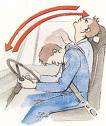 One of the most common questions asked by anyone suffering from whiplash or another auto injury is, “How long do I need to recover?”
One of the most common questions asked by anyone suffering from whiplash or another auto injury is, “How long do I need to recover?”
The answer to that question depends largely on the severity of your injury, as well as individual characteristics like age, mental health, and occupation. For instance one new study suggests that patients with grade I or II whiplash injury can expect to experience significant relief of their symptoms within a year of their injury. However, other research has shown that up to half of whiplash patients develop chronic problems.
To clarify the matter, researchers from France recently conducted a study of 173 patients with whiplash and 207 individuals with mild injuries. One year after the injury, 56% of whiplash patients still had not fully recovered, compared to 43% of more mild injury cases. The biggest factor in predicting poor quality of life was post-traumatic stress disorder. Earlier studies have also indicated the PTSD increases the likelihood that whiplash patients will suffer from chronic symptoms.
The term “chronic” typically refers to any painful symptoms that are experienced for longer than three months. Unfortunately, the lingering effects of chronic whiplash can last for up to a decade after the injury, according to previous research.
So if you’re suffering from whiplash now, it’s important to be evaluated by a chiropractor or other spinal specialist who can assess the damage and grade of injury. Mild cases of whiplash may be resolved with a few chiropractic adjustments and at-home treatments, while more severe cases will require longer-term care. Seeking adequate treatment now will prevent chronic pain later.
References
Asenlöf P, et al. The clinical course over the first year of Whiplash Associated Disorders (WAD): pain-related disability predicts outcome in a mildly affected sample. BMC Musculoskeletal Disorders 2013;14(1):361. doi: 10.1186/1471-2474-14-361.
Hours M, et al. One year after mild injury: comparison of health status and quality of life between patients with whiplash versus other injuries. Journal of Rheumatology 2013.

